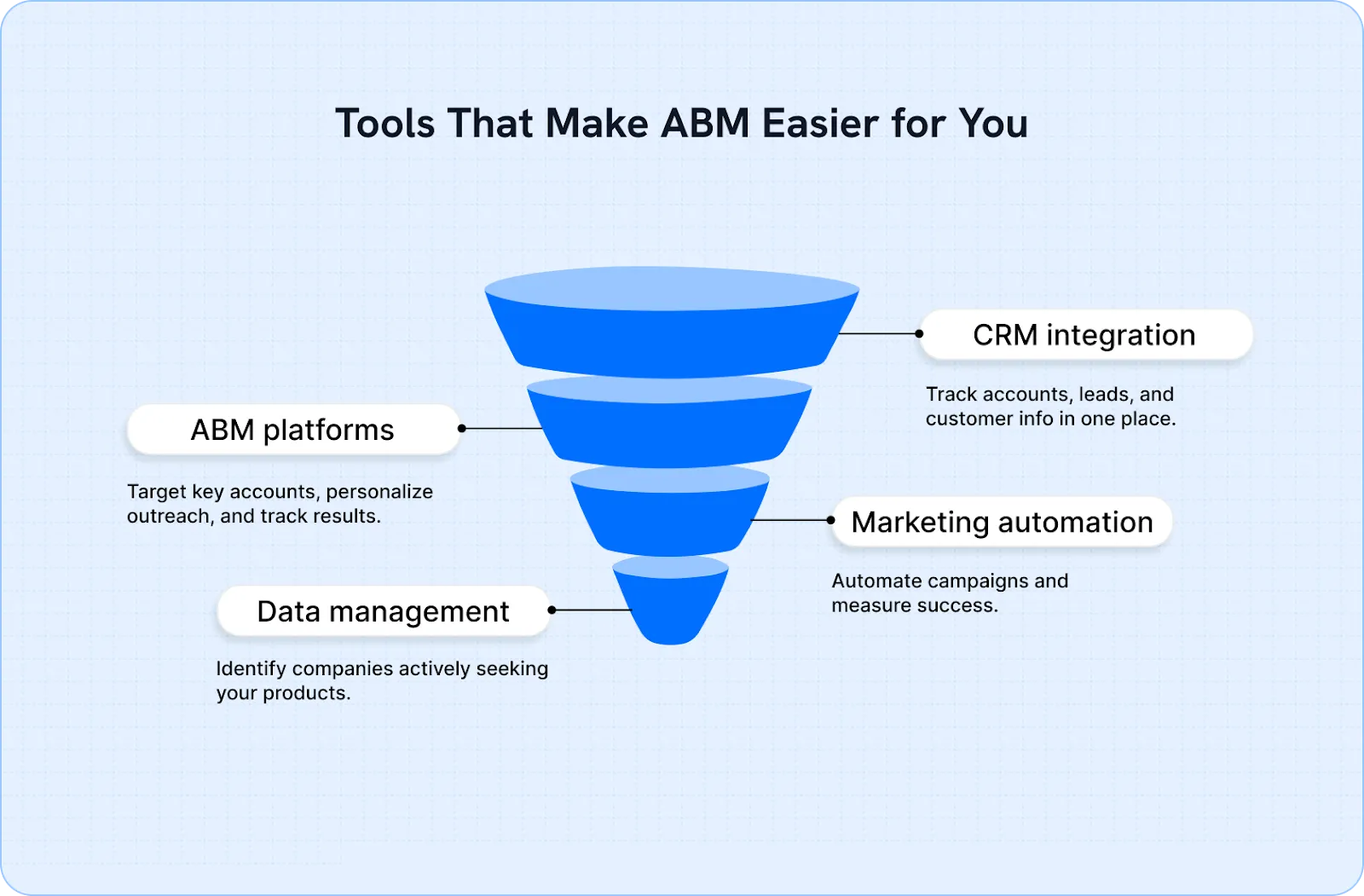Your biggest competitor just landed a $500K contract with a company you didn't even know was looking for suppliers. While you were waiting for the next trade show, they were already having conversations with your perfect customers.
The buyers who need exactly what you make are out there right now, researching suppliers and making decisions.
The question is: are they finding you, or are they finding everyone else first?
Account-based marketing or ABM ensures they find you first; not your competitors.
TL;DR
- ABM helps manufacturers avoid wasting resources on unqualified leads by targeting top-fit accounts.
- Prioritizing the right manufacturing companies builds stronger, more profitable relationships.
- Aligning marketing and sales ensures consistent engagement with key decision-makers.
- Modern ABM strategies generate steady leads beyond trade shows, ads, or generic outreach.
- 99% of companies with an ABM team reported higher ROI than with traditional marketing.
- Even small manufacturing teams can run focused ABM programs for predictable, high-value growth.
What ABM Really Means (It's Not Just "Better Targeting")
Most manufacturers think ABM is just fancy talk for "targeted marketing." It's not.
Traditional marketing spreads your message to a broad audience through emails, ads, or generic campaigns and hopes someone responds. ABM flips that completely.
You pick the companies first. Then you create everything specifically for them.
Here's what that looks like: Instead of a website that just says, "We make industrial equipment," you have content that shows up when someone searches "stainless steel tanks for dairy processing" with a detailed example of how you helped a dairy company reduce contamination risk and improve production efficiency.
The buyer doesn't see another generic supplier. They see the supplier who's already solved their exact problem.

This means the time and money you put into ABM turns into actual purchase orders from companies that can afford what you're selling, instead of getting wasted on tire-kickers who were never going to buy anyway.
Why You Need Account-Based Marketing Now More Than Ever
Let's be honest about what selling manufacturing products actually looks like in 2025:
The process takes months, not days. Multiple people weigh in on decisions. Engineering wants technical specs, procurement wants competitive pricing, operations wants proven reliability, and finance wants ROI justification. Oh, and they're all researching online before they ever talk to a salesperson.
If your marketing strategy is still stuck in 2015, you're invisible when it matters most.

Here's what ABM does for your manufacturing business:
- Builds trust with the right buyers: When you speak directly to the companies that matter, they see you understand their needs. Trust grows fast, and buyers are more likely to choose your products over others.
- Strengthens relationships with decision-makers: Instead of speaking to anyone who answers the phone, connect with the engineers, operations managers, and procurement leaders who actually sign purchase orders.
- Focuses on bigger, faster deals: Your time isn’t wasted on leads that won’t buy. You target accounts that are ready to make larger orders, so deals close sooner.
The Must-Have ABM Pre-Launch Checklist: Get It Right from Day One
Starting ABM without proper preparation is like showing up to a critical customer meeting without knowing what they actually make. You might stumble through it, but you're not going to win the deal.
Most manufacturers rush straight to tactics: "Let's start sending personalized emails!" But without the foundation, you're just doing expensive direct mail with a fancy name.
Here's how to avoid that mistake:
- Team alignment and training: Get your sales, marketing, and operations teams on the same page. Everyone needs to understand which accounts matter and how to approach them.
- Target Account List (TAL) preparation: This isn't just "companies we'd like to work with." Pick companies that match your ideal customer profile (ICP): right industry, right size, right budget, right timing.
- Messaging and content development: Instead of talking your capabilities, start talking about their problems. Create messages and materials that show you understand their specific challenges and have proven solutions.
- Tech stack and data management: You need systems to track accounts, personalize outreach, and keep customer information organized. It doesn't have to be complex, but it has to work consistently.
- Integration with existing efforts: ABM works best when it amplifies your current sales and marketing activities. Plan how it connects with your trade show strategy, website content, and existing campaigns.
- Measurement plan and KPIs: Decide what success looks like before you launch. Are you measuring account engagement, pipeline velocity, deal size, or win rates? Know this upfront.
- Campaign planning and roadmap: Map out your first 90 days. Which accounts will you target first? What messages will you test? Which channels will you use? A clear plan keeps everyone focused.
Get these basics right, and your ABM program becomes a growth engine instead of another marketing experiment.
4 Steps to Start Your ABM Journey: How to Find, Engage, and Win the Best Customers

Your best sales rep just heard about a company that could become your biggest customer, but only if you approach them the right way. They've been burned by suppliers who overpromised and underdelivered, so they're skeptical of anyone new.
How do you go from unknown vendor to trusted partner? Here's the systematic approach that works:
Step 1: Find the Best Companies to Target
Don't make the classic mistake of trying to sell to everyone. You now know the drill. Start by identifying companies that match your ICP.
Look for companies that are growing, investing in new equipment, or dealing with the exact problems your products solve. These become your TAL.
Critical point: It's better to focus deeply on 50 right accounts than spread thin across 500 mediocre ones.
Step 2: Understand Your Customer’s Path
Now think about how each company makes buying decisions.
Most manufacturing purchases follow a predictable path:
- Problem Recognition: "Our current system isn't meeting demand"
- Solution Research: "What options are available to solve this?"
- Vendor Evaluation: "Which supplier can actually deliver what they promise?"
- Decision: "Let's move forward with this partner"
Your job is to be visible and helpful at each stage with the right content and messaging.
Ask your current customers: "How did you find suppliers before working with us?" Their answers tell you exactly what searches you should show up for.
Step 3: Make Plans That Speak Directly to Each Company
With your TAL in hand and a clear picture of their path, you can create messages that actually matter. Think about each company’s specific challenges and show exactly how your product solves them.
- Use channels they actually pay attention to: email, calls, meetings, or even targeted online ads.
- Make it easier for your sales team to reach decision-makers.
- Keep them interested with reminders and multi-channel follow-ups.
By tailoring your approach, you’re making it simple for the right people to say yes. This is exactly how ABM makes your marketing smarter than generic campaigns.
Step 4: Keep Building Strong Relationships Over Time
ABM isn't just about landing the first deal. Share helpful content like product tips, industry updates, and training. Use consistent touchpoints to stay engaged between projects. Building loyalty turns first-time buyers into repeat customers and referrals.
Tools That Make ABM Easier for You (Even If You’re Not a Marketing Pro)

You don’t need a marketing degree to run ABM. But you do need the right systems to manage accounts, track engagement, and personalize outreach at scale.
- CRM integration: This is where you keep track of every account and lead. You can see who’s engaged, score opportunities, and keep all customer info in one place. It’s like having a digital filing cabinet for your sales team.
- ABM platforms: These tools focus on the accounts that matter most. They help you target specific companies, personalize your messages, run campaigns, and track results. Think of it as the dashboard for your entire ABM strategy.
- Marketing automation and reporting tools: Send emails, run campaigns, and measure what’s working without doing everything manually. Some ABM platforms include these, but standalone tools can help if you want extra flexibility.
- Data management and intent data solutions: These give you insights into which companies are actively looking for products like yours. That way, you know who to reach and when, instead of guessing.
With the help of these tools, you don't have to manage endless spreadsheets or follow up with leads that go nowhere.
Is Your Account Based Marketing Paying Off? What Manufacturers Should Track
You’ve set up your ABM program and started reaching the right companies. Now, how do you know it’s working?
Focus on metrics that show business impact, not just marketing activity:
1. Pipeline Health Metrics
- Track how quickly leads move through each stage from first contact to purchase.
- See which accounts are engaging with your content and which ones need more attention.
- Example: If an account downloads your product sheets but hasn’t requested a quote, your follow-up strategy might need adjusting.
2. Revenue Outcome Metrics
- Look at deal sizes and the speed of closing orders. Are targeted accounts placing bigger orders faster than before?
- Measure win rates for your priority accounts versus others.
- Example: Compare how quickly a target account moves from interest to purchase compared with non-targeted accounts.
3. Customer Expansion Metrics
- Track repeat orders, cross-sell, or upsell opportunities from existing customers in your TAL.
- See which accounts are giving you more business over time, not just the first sale.
- Example: An account that initially bought one product now orders multiple product lines. Your ABM efforts helped build that relationship.
Metrics are useful, but numbers alone won’t grow your business.
You need execution that turns insights into actual conversations with qualified buyers.
With Gushwork, manufacturers move beyond those dashboards and spreadsheets.
We help you use the data you’ve collected to reach the right buyers at the right time, creating predictable, high-value sales opportunities.
Wrapping Up: You Shouldn’t Ignore ABM if You Want to Grow
ABM isn’t just another marketing tactic but a smarter way to grow. The accounts that matter most? You already know who they are. The challenge is getting their attention at the right moment, guiding them from curiosity to conversation, and then to a real order.
Your ABM Questions Answered: What Manufacturers Really Want to Know
1. How is ABM different from the marketing we might already be doing?
Traditional B2B marketing in manufacturing often treats every lead the same: run ads, send emails, post LinkedIn updates, hope someone bites. ABM flips that. Instead of chasing everyone, you focus on the companies that can bring in the biggest orders. You map their decision-makers, understand exactly what challenges they face like reducing downtime on a bottling line or improving yield in a fabrication process and guide them with targeted messages at every stage. It’s precision over volume.
2. Can ABM work for manufacturers like me who may not have a big marketing team or budget?
Yes. ABM doesn’t require a large team it requires focus. For example, instead of sending dozens of LinkedIn ads, you pick 20–30 accounts that match your ideal customer, map the key stakeholders in each, and deliver content or outreach that answers their exact concerns. A small team can manage this because every action is tied to a high-value account. You’re not doing more; you’re doing the right things for the right companies.
3. How do I find which companies to target in ABM if I don’t have much market data?
Start with your best customers. Look at the companies that already buy from you, what they make, their size, and who makes buying decisions. Then, identify others in the same industry or with similar challenges like food processing plants that need new packaging lines or factories expanding their automation. Industry associations, trade directories, and LinkedIn filters help you discover these accounts. Even without a huge dataset, you can build a precise target list.
4. Can ABM be automated or does it require a lot of manual work?
It’s a mix. You can automate account tracking, engagement scoring, and follow-up emails, but the core work figuring out which accounts to target, mapping stakeholders, tailoring messaging is human. For example, you can set up automated emails showing a case study on reducing line stoppages, but someone still decides which plants get the case study and when to escalate a call. Automation handles repetitive tasks; humans handle judgment calls.
5. How long does it usually take to see results from ABM?
Manufacturing buying cycles are slow. A plant manager or engineer may take weeks to evaluate suppliers because downtime is costly and multiple departments weigh in. That said, if you focus on the right accounts and deliver content that answers their real problems like a case study showing how you cut production errors by 30%, you’ll start seeing engagement within a few weeks. Real revenue impact, like signed orders, usually happens in 2-4 months. The key is consistent, relevant touchpoints, not sporadic outreach.




















.webp)








.webp)
.svg)


.svg)
.svg)
.svg)







.svg)